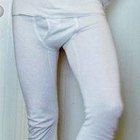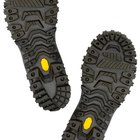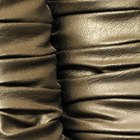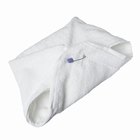
Neoprene describes a type of synthetic rubber that is used in various applications where waterproof and insulation qualities are needed. Thinsulate is a synthetic fiber thermal insulation also used in clothing. It is a weave of mixtures of various polymers, whereas neoprene is made by polymerization of chloroprene. Thinsulate is different from neoprene in many aspects, including warmth, breathability, waterproof capability and thickness.
Warmth
Thinsulate has more insulating properties than neoprene. The insulation properties of Thinsulate are more helpful for retaining some heat produced by the body than neoprene, so the wearer can be comfortable and warm. When the body sweats, Thinsulate allows the water to evaporate, whereas neoprene, a polymerized rubber compound, does not breath. Thinsulate is used as insulation in winter hats, gloves and clothing, whereas neoprene is used to create rubber diving suits and waterproof boots and work gloves.
Breathability
Thinsulate is breathable and designed to trap air molecules, but not water, within its layers. This feature helps create the material's insulative value. As the name implies, Thinsulate is thin, but its highly effective insulation properties reduce the need for heavy outerwear. Neoprene is not a breathable material, so it is more comfortable in dry conditions. Neoprene can breathe only when it is perforated, and in this condition it looses much of it's insulating, waterproofing characteristics. As a solid sheet, neoprene will dissipate excess heat, but not sweat
Waterproof Characteristics
Composed of high density, closed-cell foam rubber, neoprene has many useful waterproof properties. Water molecules will not pass through gaps in between the polymer strands in neoprene, making it perfect for boots, waterproof work gloves and scuba suits. Because Thinsulate is a woven material, it is water resistant, but not waterproof. Thinsulate insulation can become soaked with water. Therefore, the material is often woven into water-repellant clothing such as nylon.
Thickness and Wearability
Thinsulate is designed to be thin, which reduces the need for bulky outerwear. Thinsulate-insulated winter apparel is less cumbersome than clothing insulated with poly fiber or goose down. The wearer can maintain flexibility and feel comfortable for hours. On the other hand, neoprene is somewhat thicker and does not perform like fabric. Surfing wetsuits are one of the most common uses of neoprene. The material provides thickness and coverage that allows the wearer enjoy surf sessions in comfort.
Related Articles

What Is a Textile Motorcycle Jacket?

The Differences Between Fleece & ...

Differences Between Polyester and Nylon ...

Thinsulate Vs. Thermolite

The Advantages of Wool Clothing

Microfiber vs. Cotton Clothes

How Does Thermal Underwear Work?

Shoe Sole Materials

What Is the Difference Between Lycra ...

What Season to Wear Corduroys?

The Difference Between Polartec and ...

What Is Polyurethane Coated Leather?

Description and Characteristics of ...

What Are the Benefits of Kangaroo ...

Cordura Vs. Leather

Characteristics of Polyester & Cotton

Microfleece Vs. Microplush

What Is Berber Fleece?

When to Wear a Wetsuit in Open-Water ...

Alternatives to Neoprene
References
Writer Bio
Since 2003, Timothy Burns' writing has appeared in magazines, management and leadership papers. He has contributed to nationally published books and he leads the Word Weavers of West Michigan writers' group. Burns wrote "Forged in the Fire" in 2004, and has published numerous articles online. As a trained conference speaker, Burns speaks nationally on the art, science and inspiration of freelance writing.
Photo Credits
PhotoObjects.net/PhotoObjects.net/Getty Images